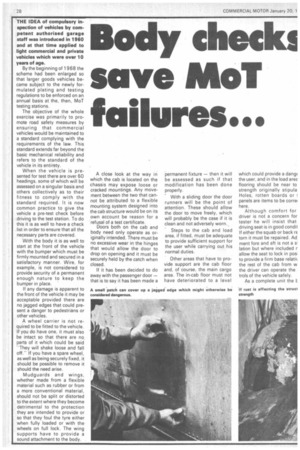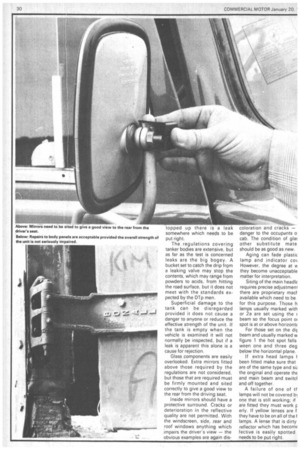Body chedu save NWT failures...
Page 30

Page 31

Page 32

If you've noticed an error in this article please click here to report it so we can fix it.
'THE IDEA of compulsory inspection of vehicles by com petent authorised garage staff was introduced in 1960 and at that time applied to light commercial and private vehicles which were over 10 years of age.
By the beginning of 1968 the scheme had been enlarged so that larger goods vehicles be
came subject to the newly formulated plating and testing
regulations to be enforced on an annual basis at the, then, MoT testing stations.
The objective of the whole exercise was primarily to pro mote road safety measures by ensuring that commercial vehicles would be maintained to a standard complying with the requirements of the law. This standard extends far beyond the basic mechanical reliability and refers to the standard of the vehicle in its entirety.
When the vehicle is presented for test there are over 60 headings, some of which will be assessed on a singular basis and others collectively as to their fitness to comply with the standard required. It is now common practice to give the vehicle a pre-test check before driving to the test station. To do this it is as well to have a check list in order to ensure that all the necessary parts are covered.
With the body it is as well to start at the front of the vehicle with the bumper which must be firmly mounted and secured in a satisfactory manner. Wire, for example, is not considered to provide security of a permanent enough nature to keep the bumper in place. "
If any damage is apparent to the front of the vehicle it may be acceptable provided there are no jagged edges that could present a danger to pedestrians or other vehicles.
A wheel carrier is not required to be fitted to the vehicle.
If you do have one, it must also be intact so that there are no parts of it which could be said "They will shake loose and fall off." If you have a spare wheel, as well as being securely fixed, it should be possible to remove it should the need arise.
Mudguards and wings, whether made from a flexible material such as rubber or from a more conventional material, should not be split or distorted to the extent where they become detrimental to the protection they are intended to provide or so that they foul the tyre either when fully loaded or with the wheels on full lock. The wing supports have to provide a sound attachment to the body. A close look at the way in which the cab is located on the chassis may expose loose or cracked mountings. Any movement between the two that cannot be attributed to a flexible mounting system designed into the cab structure would be on its own account be reason for a refusal of a test certificate.
Doors both on the cab and body need only operate as originally intended. There must be no excessive wear in the hinges that would allow the door to drop on opening and it must be securely held by the catch when closed.
If it has been decided to do away with the passenger door — that is to say it has been made a permanent fixture — then it will be assessed as such if that modification has been done properly.
With a sliding door the door runners will be the point of attention. These should allow the door to move freely, which will probably be the case if it is clean and not adversely worn, Steps to the cab and load area, if fitted, must be adequate to provide sufficient support for the user while carrying out his normal duties.
Other areas that have to provide support are the cab floor and, of course, the main cargo area. The in-cab floor must not have deteriorated to a level which could provide a darigE the user, and in the load area flooring should be near to strength originally stipula Holes, rotten boards or 1 panels are items to be correi here.
Although comfort for driver is not a concern for tester he will insist that driving seat is in good condii If either the squab or back r€ torn it must be repaired. Ad. ment tore and aft is not a si lation but where included r allow the seat to lock in posi to provide a firm base relath the rest of the cab from w the driver can operate the trols of the vehicle safely.
As a complete unit the L )uld appear to sit squarely I firmly on the chassis.
Bolts and rivets securing the igitudinal and transverse rigs have been known to rk loose and in some cases cture; where this has hapled they should be tightened replaced. Where bolts are viously missing these too ad to be replaced.
It is normal for bodies to have :ertain amount of give which DWS shock loads to be ab:bed without damage to the ucture. This inbuilt flexibility. lot to be confused with simicharacteristics which arise
m insecure mountings.
With dropside and lboards, take a good look at )ges and retaining devices. e hinges must not only allow per movement of the body nel, but, with the help of ainmg devices, support the nel's weight as well as proling adequate means to con n the load.
The tipping gear on tipping dies is probably the most glected item on the vehicle. The failure of the hydraulic al on the ram is a common lit, usually caused by some reign body by-passing the per seal. Any oil on the ram is iign of a leak although it may insufficient at first to affect performance of the equipmt.
This is the time to take some nedial action: don't wait until a pressure loss is so great that a ram can no longer lift the dy to discharge the load. If a hydraulic system has to be topped up there is a leak somewhere which needs to be put right.
The regulations covering tanker bodies are extensive, but as far as the test is concerned leaks are the big bogey. A bucket set to catch the drip from a leaking valve may stop the contents, which may range from powders to acids, from hitting the road surface, but it does not meet with the standards expected by the Dip men.
Superficial damage to the tank can be disregarded provided it does not cause a danger to anyone or reduce the effective .strength of the unit. If the tank is empty when the vehicle is examined it will not normally be inspected, but if a leak is apparent this alone is a cause for rejection.
Glass components are easily overlooked. Extra mirrors fitted above those required by the regulations are not considered, but those that are required must be firmly mounted and sited correctly to give a good view to the rear from the driving seat.
Inside mirrors should have a protective surround. Cracks or deterioration in the reflective quality are not permitted. With the windscreen, side, rear and roof windows anything which impairs the driver's view — the obvious examples are again dis coloration and cracks danger to the occupants o. cab. The condition of glat other substitute mate should be as good as new.
Aging can fade plastic lamp and .indicator co‘ However, the degree at v% they become unacceptable matter for interpretation.
Siting of the main headIE requires precise adjustmeni there are proprietary mach available which need to be for this purpose. Those h lamps usually marked with or 2a are set using the t beam so the focus point oi spot is at or above horizontz For those set on the dif beam and usually marked w figure 1 the hot spot falls ween one and three deg below the horizontal plane.
If extra head lamps h been fitted make sure that are of the same type and si2 the original and operate the and main beam and switch and off together.
A failure of one of thlamps will not be covered one that is still working; if are fitted they must work p erly. If yellow lenses are f they have to be on all of the h lamps. A lense that is dirty reflector which has become fective is easily spotted needs to be put right.
















































































































